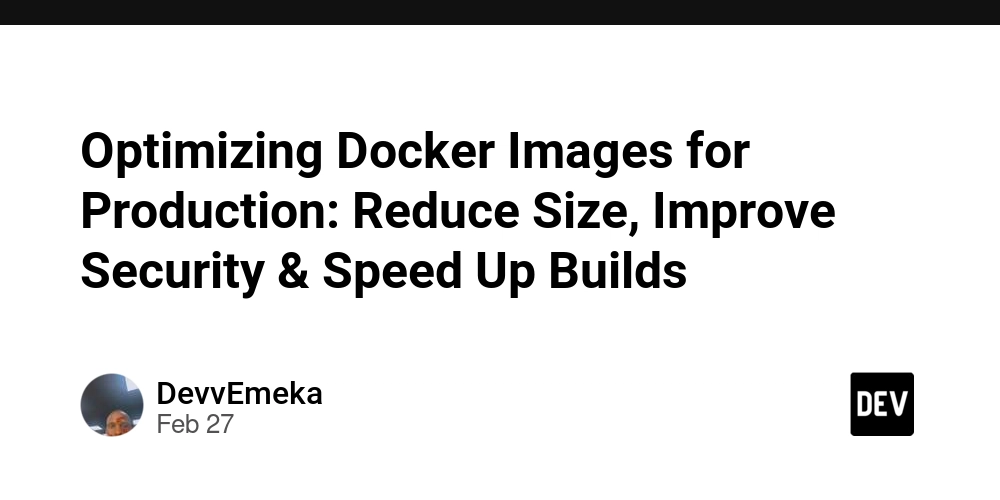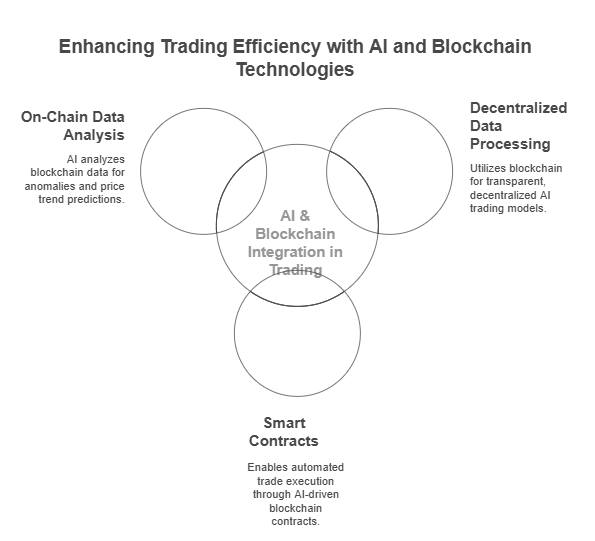Optimizing Docker Images for Production: Reduce Size, Improve Security & Speed Up Builds
Introduction Docker images are the backbone of containerized applications. However, without proper optimization, they can become bloated, slow, and insecure. Large images increase storage requirements, slow down deployments, and introduce unnecessary vulnerabilities. In this guide, we will explore practical methods to optimize Docker images by reducing size, improving security, and speeding up build processes. Reducing Docker Image Size Minimizing the size of your Docker image leads to faster build times, reduced attack surface, and improved runtime performance. Here are some effective ways to achieve this: Using Minimal Base Images Choosing a lightweight base image significantly reduces the overall image size. For example, using alpine, which is only ~5MB, instead of a full-size Linux distribution like ubuntu (which can be over 100MB), helps keep your image small. Example: FROM alpine:latest RUN apk --no-cache add curl CMD ["/bin/sh"] For Go applications, you can use scratch, an empty image that contains nothing: FROM scratch COPY myapp / CMD ["/myapp"] Multi-Stage Builds Multi-stage builds separate the build environment from the final production image, reducing the final image size by keeping only essential files. Example: # Build Stage FROM golang:1.19 AS builder WORKDIR /app COPY . . RUN go build -o myapp # Production Stage FROM alpine:latest WORKDIR /root/ COPY --from=builder /app/myapp . CMD ["./myapp"] This method ensures that unnecessary build tools and dependencies do not make it into the final image. Removing Unnecessary Files To prevent unnecessary files from being included in the image, use a .dockerignore file: node_modules .git *.log This reduces build context size, leading to faster and leaner builds. Optimizing Layer Usage Each RUN instruction creates a new layer. Combining multiple commands into a single RUN reduces layer count and image size: RUN apt-get update && \ apt-get install -y curl && \ rm -rf /var/lib/apt/lists/* Improving Docker Image Security Security is a critical aspect of Docker image optimization. Here’s how to build more secure images: Using Official & Trusted Images Only use verified base images from official sources, such as Docker Hub’s official repositories, AWS Elastic Container Registry (ECR), or Google Artifact Registry. Avoid pulling images from unknown sources to prevent security risks. Scanning for Vulnerabilities Regularly scan your images for vulnerabilities using tools like: docker scan (built into Docker CLI) Trivy (by Aqua Security) Anchore or Clair Example usage with Trivy: trivy image myapp:latest Avoiding Running as Root Running containers as root is a security risk. Instead, create a non-root user: RUN addgroup -S appgroup && adduser -S appuser -G appgroup USER appuser This limits the impact of potential security breaches. Keeping Dependencies Updated Outdated dependencies are a common security risk. Regularly update packages and remove unnecessary ones: RUN apk add --no-cache --update curl Keeping images up to date with security patches helps prevent exploits. Speeding Up Docker Builds Optimizing build speed improves development efficiency and reduces deployment times. Here are some techniques: Leveraging Build Cache Docker caches intermediate layers to speed up rebuilds. To maximize caching, order your commands efficiently: COPY package.json . RUN npm install COPY . . Placing COPY . . at the end ensures dependency installation is only rerun when package.json changes. Enabling Parallel Builds with BuildKit BuildKit speeds up builds using parallel execution and advanced caching: DOCKER_BUILDKIT=1 docker build . Using docker buildxfor Multi-Platform Builds For multi-architecture support, use buildx: docker buildx build --platform linux/amd64,linux/arm64 -t myapp:latest . This allows building images for different CPU architectures in a single step. Conclusion Optimizing Docker images is crucial for efficient, secure, and fast containerized applications. By selecting minimal base images, leveraging multi-stage builds, applying security best practices, and using build optimizations, you can create production-ready images that are lightweight, secure, and fast to deploy. Start applying these techniques to improve your Docker workflow and enhance your application's performance today!

Introduction
Docker images are the backbone of containerized applications. However, without proper optimization, they can become bloated, slow, and insecure. Large images increase storage requirements, slow down deployments, and introduce unnecessary vulnerabilities. In this guide, we will explore practical methods to optimize Docker images by reducing size, improving security, and speeding up build processes.
Reducing Docker Image Size
Minimizing the size of your Docker image leads to faster build times, reduced attack surface, and improved runtime performance. Here are some effective ways to achieve this:
Using Minimal Base Images
Choosing a lightweight base image significantly reduces the overall image size. For example, using alpine, which is only ~5MB, instead of a full-size Linux distribution like ubuntu (which can be over 100MB), helps keep your image small.
Example:
FROM alpine:latest
RUN apk --no-cache add curl
CMD ["/bin/sh"]
For Go applications, you can use scratch, an empty image that contains nothing:
FROM scratch
COPY myapp /
CMD ["/myapp"]
Multi-Stage Builds
Multi-stage builds separate the build environment from the final production image, reducing the final image size by keeping only essential files.
Example:
# Build Stage
FROM golang:1.19 AS builder
WORKDIR /app
COPY . .
RUN go build -o myapp
# Production Stage
FROM alpine:latest
WORKDIR /root/
COPY --from=builder /app/myapp .
CMD ["./myapp"]
This method ensures that unnecessary build tools and dependencies do not make it into the final image.
Removing Unnecessary Files
To prevent unnecessary files from being included in the image, use a .dockerignore file:
node_modules
.git
*.log
This reduces build context size, leading to faster and leaner builds.
Optimizing Layer Usage
Each RUN instruction creates a new layer. Combining multiple commands into a single RUN reduces layer count and image size:
RUN apt-get update && \
apt-get install -y curl && \
rm -rf /var/lib/apt/lists/*
Improving Docker Image Security
Security is a critical aspect of Docker image optimization. Here’s how to build more secure images:
Using Official & Trusted Images
Only use verified base images from official sources, such as Docker Hub’s official repositories, AWS Elastic Container Registry (ECR), or Google Artifact Registry. Avoid pulling images from unknown sources to prevent security risks.
Scanning for Vulnerabilities
Regularly scan your images for vulnerabilities using tools like:
docker scan(built into Docker CLI)Trivy(by Aqua Security)AnchoreorClair
Example usage with Trivy:
trivy image myapp:latest
Avoiding Running as Root
Running containers as root is a security risk. Instead, create a non-root user:
RUN addgroup -S appgroup && adduser -S appuser -G appgroup
USER appuser
This limits the impact of potential security breaches.
Keeping Dependencies Updated
Outdated dependencies are a common security risk. Regularly update packages and remove unnecessary ones:
RUN apk add --no-cache --update curl
Keeping images up to date with security patches helps prevent exploits.
Speeding Up Docker Builds
Optimizing build speed improves development efficiency and reduces deployment times. Here are some techniques:
Leveraging Build Cache
Docker caches intermediate layers to speed up rebuilds. To maximize caching, order your commands efficiently:
COPY package.json .
RUN npm install
COPY . .
Placing COPY . . at the end ensures dependency installation is only rerun when package.json changes.
Enabling Parallel Builds with BuildKit
BuildKit speeds up builds using parallel execution and advanced caching:
DOCKER_BUILDKIT=1 docker build .
Using docker buildxfor Multi-Platform Builds
For multi-architecture support, use buildx:
docker buildx build --platform linux/amd64,linux/arm64 -t myapp:latest .
This allows building images for different CPU architectures in a single step.
Conclusion
Optimizing Docker images is crucial for efficient, secure, and fast containerized applications. By selecting minimal base images, leveraging multi-stage builds, applying security best practices, and using build optimizations, you can create production-ready images that are lightweight, secure, and fast to deploy.
Start applying these techniques to improve your Docker workflow and enhance your application's performance today!












































































































































































![[The AI Show Episode 142]: ChatGPT’s New Image Generator, Studio Ghibli Craze and Backlash, Gemini 2.5, OpenAI Academy, 4o Updates, Vibe Marketing & xAI Acquires X](https://www.marketingaiinstitute.com/hubfs/ep%20142%20cover.png)



























































































































![[DEALS] The Premium Learn to Code Certification Bundle (97% off) & Other Deals Up To 98% Off – Offers End Soon!](https://www.javacodegeeks.com/wp-content/uploads/2012/12/jcg-logo.jpg)


![From drop-out to software architect with Jason Lengstorf [Podcast #167]](https://cdn.hashnode.com/res/hashnode/image/upload/v1743796461357/f3d19cd7-e6f5-4d7c-8bfc-eb974bc8da68.png?#)









































































































.png?#)

































_Christophe_Coat_Alamy.jpg?#)
 (1).webp?#)




































































































![iPhone 17 Pro Won't Feature Two-Toned Back [Gurman]](https://www.iclarified.com/images/news/96944/96944/96944-640.jpg)
![Tariffs Threaten Apple's $999 iPhone Price Point in the U.S. [Gurman]](https://www.iclarified.com/images/news/96943/96943/96943-640.jpg)





































































































































